| | | The Influences Of Historical Battlefields. |    |
| |
| Author | Message |
|---|
Meles meles
Censura
Posts : 5081
Join date : 2011-12-30
 |  Subject: Re: The Influences Of Historical Battlefields. Subject: Re: The Influences Of Historical Battlefields.  Wed Oct 12, 2022 12:45 pm Wed Oct 12, 2022 12:45 pm | |
| Regarding the name of the Battle of Waterloo (and hence of Waterloo station in London), it was of course named after the village of Waterloo, adjacent to the battlefield and situated on the main road leading south out of Brussels just 16km away to the north. However there were several other villages and hamlets dotted around the battlefield with their own significance to the events, and in the immediate aftermath of the battle the name Waterloo, while commonly used by the British and Dutch, was not universally accepted. The French generally referred to it as the 'Battle of Mont Saint-Jean' after the village of that name which was close to the ridge upon which Wellington drew up his combined forces and faced Napoleon. Meanwhile the Prussian commander, von Blücher, preferred the evocative name of the 'Battle of La Belle Alliance' after the name of the inn close to where he finally met Wellington face-to-face in the closing stages of the battle after the Prussian army had arrived on the field just in time to save the day. By mid July - a month after the battle - the British press were still debating the competing merits of the different names but it was Wellington’s stated dislike for 'La Belle Alliance' which seems to have carried the day. By the time that a 'Waterloo Medal' was issued to all participants in the battle (regardless of rank) the following year, the name was firmly established in the British public consciousness and, with Wellington now established as head of the allied army of occupation in Paris, by foreign commentators as well.
As a name for London's International railway terminus - linked by the Channel Tunnel to Paris and Brussels, and then onwards to other cities thoughout Europe - the name 'Belle Alliance International station' could not have been more appropriate. But history is what it is.
Last edited by Meles meles on Fri Oct 14, 2022 11:12 am; edited 8 times in total (Reason for editing : too many, and then not enough, prepositions) |
|   | | LadyinRetirement
Censura

Posts : 3305
Join date : 2013-09-16
Location : North-West Midlands, England
 |  Subject: Re: The Influences Of Historical Battlefields. Subject: Re: The Influences Of Historical Battlefields.  Wed Oct 12, 2022 4:38 pm Wed Oct 12, 2022 4:38 pm | |
| There's a Waterloo Station on the Liverpool to Southport railway between Seaforth and Blundellsands (I believe the Seaforth station is now called Seaforth & Litherland and Blundellsands is known as Blundellsands and Crosby). I used to have relations in Waterloo who moved to Crosby; the part of Crosby where my relations used to live was nearer to Waterloo Station than Blundellsands Station though I had an auntie and uncle who had a flat in Blundellsands for a time. I may have mentioned at some time that I once told a childhood friend that I'd been to see some relatives in Waterloo (the Liverpool outskirts one) and her dad said "That's next to Seaforth isn't it?". I told my mum about the conversation and she said "You tell him that my sister lives at the Crosby end of Waterloo". I think Crosby was thought to be more upmarket than Seaforth. |
|   | | Vizzer
Censura

Posts : 1818
Join date : 2012-05-12
 |  Subject: Re: The Influences Of Historical Battlefields. Subject: Re: The Influences Of Historical Battlefields.  Wed Oct 19, 2022 12:11 am Wed Oct 19, 2022 12:11 am | |
| - Meles meles wrote:
- It was rather unfortunate that in the 1980s, with France and Britain having finally agreed to cooperate in building the Channel Tunnel linking the countries' capital cities by rail, the only suitable London station, at least until 2007, was Waterloo - named after the crushing French defeat in 1815. Strictly of course Waterloo station takes its name from the nearby road bridge over the Thames which was still under construction at the time of the battle and was to have been called Strand Bridge. However the military victory immediately prompted calls for it to be renamed Waterloo Bridge. By the time the railway station opened in 1848 the whole area on the south of the Thames leading up to the bridge had been known as Waterloo for over three decades, hence the station's name.
I hadn’t appreciated that the name of the bridge and neighbouring area predated Waterloo Station. That’s fascinating. Being built 30 years after the battle, it’s almost a pity that it wasn’t built later still. 6 years after its opening, the British and the French were allies during the Crimean War. If the station were to be named after a battle from that war, then ‘Balaclava Station’ could have been the result. - Meles meles wrote:
- Solférino (Line 12) - named after the town of Solférino in Italy where the French under Napoleon III defeated an Austrian army in 1859. The appalling death toll and the suffering of the wounded (of both sides) ultimately led to the Geneva Conventions and the establishment of the International Red Cross.
Stalingrad (Line 2) - commemorates hugely significant battle of Stalingrad where in 1943 Russian forces finally defeated the besieging German army in one of the bloodiest battles in history with something like 2 million total casualties. June of 1859 gave names to, not 1, but 2 stations in Paris. A battle fought 3 weeks before Solférino was Magenta which is the name of a boulevard and also a station on the RER Ligne E. Not to be outdone, the exploits of the earlier Napoleon (Bonaparte) at the battle of Wagram in 1809 (also against the Austrians) is remembered by a métro station on Line 3 bearing its name. It’s interesting what you say Meles about Paris probably having more métro stations named after battles than any other city. Even Moscow and St Petersburg, for instance, don’t really go in for stations named after battles. There is no Stalingrad metro station in either city. Neither does Stockholm have any stations named after famous battles. It does have a Narvavägen which is a grand avenue named after the 1700 victory of Charles XII ‘the Swedish Meteor’ over the Russians at Narva in Estonia. There is also a Breitenfeldsgatan named after the 1631 victory of King Gustavus II Adolphus over the Holy Roman Empire at Breitenfeld near Leipzig. It’s a smart residential mews built in the 1910s and thus relatively understated. In neighbouring Finland is Sodankylä which translates as ‘War Village’ and is indeed a garrison town of the Finnish army. The Lapland town dates from the 17th century at least although the origin of the name Sodankylä is obscure and disputed. It’s a similar story in England’s Wiltshire where Warminster and the adjacent village of Battlesbury form a garrison town of the British army. The origins of both names (Warminster and Battlesbury) are also obscure and disputed. The ancient hill fort at Battlesbury Camp on the edge of Salisbury Plain dates back about 3,000 years while Warminster dates from at least Saxon times and was itself the scene of a skirmish in the English Civil War of the 1640s. That conflict would also see a battle between royalists and parliamentarians fought at Turnham Green in Middlesex. Turnham Green is the name of a London Underground station serving the District and Piccadilly lines (above ground). Being the scene of a battle, however, rather than being named after a battle as such, probably means that Turnham Green doesn’t count. For the same reason neither would Blackheath Station in Kent. Part of Greater London’s overground network, the station takes its name from the village of Blackheath which was the scene of a battle in 1497 during the Cornish Rebellion. An alternative name for that battle is the battle of Deptford Bridge which is also the name of a station on the Docklands Light Railway. |
|   | | Meles meles
Censura

Posts : 5081
Join date : 2011-12-30
Location : Pyrénées-Orientales, France
 |  Subject: Re: The Influences Of Historical Battlefields. Subject: Re: The Influences Of Historical Battlefields.  Wed Oct 19, 2022 12:42 pm Wed Oct 19, 2022 12:42 pm | |
| - Vizzer wrote:
- June of 1859 gave names to, not 1, but 2 stations in Paris. A battle fought 3 weeks before Solférino was Magenta which is the name of a boulevard and also a station on the RER Ligne E. Not to be outdone, the exploits of the earlier Napoleon (Bonaparte) at the battle of Wagram in 1809 (also against the Austrians) is remembered by a métro station on Line 3 bearing its name.
Well done for those additional Métro stations. I'd also missed: Alésia (Line 4) - which refers to the adjacent Rue d'Alésia, named for the Battle of Alesia in 52 BCE between the Gauls of Vercingetorix and the Romans of Julius Caesar. Pyramides (Lines 7 and 14) - which commemorates the victory in 1798 of Napoleon's Armée d'Orient over the Mamluks of Murad Bey in the Battle of the Pyramids in Egypt. Réaumur–Sébastopol (Lines 3 and 4) - which opened in 1904 as Rue Saint-Denis but was renamed in 1907 after the adjacent Rue Réaumur and the Boulevard de Sébastopol, which are themselves named after the scientist René-Antoine Ferchault de Réaumur and in commemoration of the Siege of Sevastopol (1854–1855). .... and not a battle as such but there's also, Crimée (Line 7) named after the nearby rue de Crimée, the longest road in the 19th arrondissement, whose name commemorates the Crimean War (1855–56). And I can't resist this one: Le Kremlin–Bicêtre (Line 7) - named after the commune it is located in. The name is derived from a tavern "Au sergent du Kremlin", which opened in 1813 as a meeting place for French war veterans, especially those from the disasterous retreat from Moscow, and Bicêtre, whose name has an even more interesting origin. The name Bicêtre is a corruption of Winchester (in England) evolving from Winchestre, through Bichestre and Bicestre to Bicêtre (in modern French ê very often denotes a following letter s having been lost from the medieval French but which is retained in English, hence forêt/forest, interêt/interest, bête/beast etc, while a letter c before an e is pronounced like the English s). In 1286 Jean de Pontoise, Bishop of Winchester and the English Ambassador to France, bought a small farm here, originally known as la Grange-aux-Queux, where he built a grand house which he called "Winchester" after his episcopal title. Unfortunately for the bishop in 1294 King Philippe IV of France confiscated the building and its lands on the pretext of his war with Edward II of England, and then towards the end of the 14th century Philippe's successor Charles VI knocked down the bishop's house and built a magnificent château on the site. The castle became a plague hospital in 1519, a military hospital in 1632, a hospice/prison for the mentally ill and other "indésirables" in 1656 and by the time of the Revolution it was a state prison for political prisoners (apparently more notorious than even the Bastille), before reverting to a general hospital in the 19th century. Largely rebuilt in the mid-20th century Hôpital Bicêtre is now a large modern university hospital but still bearing the corrupted name of the Bishop of Winchester.
Last edited by Meles meles on Thu Oct 20, 2022 1:04 am; edited 1 time in total (Reason for editing : got my French kings muddled) |
|   | | Green George
Censura

Posts : 805
Join date : 2018-10-20
Location : Kingdom of Mercia
 |  Subject: Re: The Influences Of Historical Battlefields. Subject: Re: The Influences Of Historical Battlefields.  Wed Oct 19, 2022 3:19 pm Wed Oct 19, 2022 3:19 pm | |
| I'm sure Dunkirk is a pernicious influence in modern day Britain. When something bad is going on (as it is now and so frequently in recent times) we see appeals to the Dunkirk Spirit / Battle of Britain mentality etc etc - in other words, endure, don't fix the problem. |
|   | | Green George
Censura

Posts : 805
Join date : 2018-10-20
Location : Kingdom of Mercia
 |  Subject: Re: The Influences Of Historical Battlefields. Subject: Re: The Influences Of Historical Battlefields.  Wed Oct 19, 2022 5:34 pm Wed Oct 19, 2022 5:34 pm | |
| Another corrupted name "Vokzal", generic station name for Russian railway station derived from "vauxhall" - not from Vauxhall station (although the Russian fact-finders did visit it later) but from the Vauxhall Pleasure Gardens - as the first Russian line ran from St Petersburg to the pleasure gardens. |
|   | | Priscilla
Censura

Posts : 2769
Join date : 2012-01-16
 |  Subject: Re: The Influences Of Historical Battlefields. Subject: Re: The Influences Of Historical Battlefields.  Wed Oct 19, 2022 8:02 pm Wed Oct 19, 2022 8:02 pm | |
| As ever , fascinate by the wealth of knowledge and research that crops up in these posts. I suppose Blenheim figures as a house name somewhere - but what of other house/ estates - and roads even? I know Sevastopol was used - why I have no idea. |
|   | | Green George
Censura

Posts : 805
Join date : 2018-10-20
Location : Kingdom of Mercia
 |  Subject: Re: The Influences Of Historical Battlefields. Subject: Re: The Influences Of Historical Battlefields.  Wed Oct 19, 2022 11:58 pm Wed Oct 19, 2022 11:58 pm | |
| Erm. Blenheim. Erm. https://www.blenheimpalace.com/Yes, there's a Sebastopol Road about 5 miles from here. The use of "Kop" for football terraces derives from the battle of Spion Kop. |
|   | | Priscilla
Censura

Posts : 2769
Join date : 2012-01-16
 |  Subject: Re: The Influences Of Historical Battlefields. Subject: Re: The Influences Of Historical Battlefields.  Thu Oct 20, 2022 12:02 pm Thu Oct 20, 2022 12:02 pm | |
| Not having a lot on, I casually looked up a few battles with road/house/avenue tagged on and was staggered by just how many battle names have been used - from naval battles ( even Camperdown 1797, which surprised me with a big house in Dundee.) Not Sluys, I noticed - so gap in the market there. It may well have been covered in earlier posts here, but I was surprised by the attention to Agincourt in the Monmouth area - couldn't find the reason so made assumptions about Henry Five's bowmen. Most battle named roads seemed to have been a Victorian fad but many are earlier. Seven years War battles - such as Plassey are also included in the dip in naming box - and even Dunkirk...... |
|   | | Meles meles
Censura

Posts : 5081
Join date : 2011-12-30
Location : Pyrénées-Orientales, France
 |  Subject: Re: The Influences Of Historical Battlefields. Subject: Re: The Influences Of Historical Battlefields.  Sat Oct 22, 2022 11:34 am Sat Oct 22, 2022 11:34 am | |
| Nothing as grand as Blenheim Palace but according to the 1881 census my grandfather's uncle lived in Alma House (actually a rather small cottage). The numerous roads named after 18th and 19th century battles - Trafalgar, Waterloo, Inkerman, Corunna, Ramilles, Plassey and the rest - do not surprise me. One name though that I didn't realise was derived from a battle is Portobello Road, in particular that in North Kensington, London. Prior to 1740 it was known as Green's Lane – a winding country path between the villages of Kensington and Kensal Green - but in that year a farm, Portobello Farm, was built next to the road in the area of Notting Hill, near what is now Golborne Road. The farm took its name from the victory of the previous year during the so-called War of Jenkins' Ear, when Admiral Edward Vernon captured the Spanish-ruled town of Puerto Bello, now known as Portobelo in modern-day Panama. |
|   | | Green George
Censura

Posts : 805
Join date : 2018-10-20
Location : Kingdom of Mercia
 |  Subject: Re: The Influences Of Historical Battlefields. Subject: Re: The Influences Of Historical Battlefields.  Sat Oct 22, 2022 2:47 pm Sat Oct 22, 2022 2:47 pm | |
| Yes, there's an area known as Portobello in Wolvo too.
And a street in Swindon (Staffs) named after the Falkands campaign.
Wouldn't mind living in "Glorious 1st of June Gardens" if someone cares to built a suitable dwelling in such a place. |
|   | | Tim of Aclea
Triumviratus Rei Publicae Constituendae

Posts : 594
Join date : 2011-12-31
 |  Subject: Re: The Influences Of Historical Battlefields. Subject: Re: The Influences Of Historical Battlefields.  Wed May 10, 2023 7:51 pm Wed May 10, 2023 7:51 pm | |
| Athelstaneford is said to be a beautiful little village in East Lothian, nestling in the Garleton Hills, a mile or so from Haddington, the main town of the county. It is here that it is claimed that the origins of the Scottish flag, the Saltire, were occasioned by the results of a famous battle. The story is that a certain Saxon or Anglian king or prince, Athelstan, was in East Lothian at the head of a large army, when he came across an army of Scots or Picts, or a combination of the two led by one Angus, Hungus, or Oengus. Being surrounded and heavily outnumbered, King Angus prayed to St Andrew and just before the battle, a Saltire appeared in the sky formed by white clouds against a blue background. This represented the shape of the cross on which Andrew had been crucified and seemed a sign from above that the Scots or Picts would prevail that day. It gave added strength and purpose to Angus and his men and a great victory against overwhelming odds followed. As a result Scotland was saved from destruction. Athelstan’s head was cut off and displayed on top of a long pole on the little island of Inch Garvie, Gaelic for ‘rough island’, in the Firth of Forth. Ever after, the Scots and Picts showed a great devotion to St Andrew and the Saltire became Scotland’s national flag and Andrew their patron saint.
This was according to Walter Bower, (1385-1449) a Scottish Augustinian monk from Haddington, who wrote a history of Scotland in Latin called the Scotichronicon. He wrote it in an Augustinian monastery on the isle of Inchcolm, Gaelic for ‘Columba’s island’. St Andrews University had been founded in 1410, and he had been amongst the earliest students to graduate. He had also been attached to St Andrews Cathedral. In 1417 he became the Abbot of Inchcolm monastery and commenced his great work using and building on the earlier work of John of Fordun, who died in 1384. Bower was the first person to identify Athelstaneford with a battle between Picts and Angles, but there is no mention of Scots. The present day church in Athelstaneford, built on the site of an older church founded in the twelfth century flies the Saltire in its grounds and has a historical display concerning the legendary battle in a sixteenth century building to the rear of the church.
The first question is when did the battle happen? Well according to the website Scotland’s source the battle was in 832 AD. However according to ‘Siol nan Gaidheal’ in his post on Scotland’s supposedly bloodiest battle it was in 834 AD. What is more he accuses the English as of having invaded Scotland whereas Athelstaneford is in what would then have then been Northumbria. But even more puzzling according to GENUKI the battle was won by Angus mac Fergus king of the Picts (731 to 761); it does not give the date of the battle.
In 832 or 834 the only English king called Athelstan was the king of East Anglia. The major English kingdom at that period was Wessex under Egbert and in 829 at Dore Northumbria had submitted to him. To get around this uncomfortable fact the English leader defeated is described as a “dux” or commander of the Northumbrian army. Alternatively the English king is claimed to be Eadbert of Northumbria (737/738 to 758) and yet Eadbert was allied to the Picts, they attacked the British stronghold of Dumbarton in around 756. I would also question that a significant English army at this period would be commanded by someone other than the king. Why also should the place be named after a losing commander, especially as the area in question continued under Northumbrian control for a long time afterwards.
There is, however, an English king called Athelstan who was both famous enough and powerful enough to have somewhere named after him and that is the king of the English from 924 to 939 who not only successfully invaded and ravaged the Scottish kingdom of Alba in 934 (significantly exactly 100 years after one of the claimed dates for Athelstaneford), the Pictish kingdom had ended by then. He also defeated a coalition of Scots, Britons and Norse Irish at the Battle of Brunanburh in 937 and forced the Scots and other Celtic nations to pay homage to him as not just King of the English but ruler of Britain (rex Anglorum et eque totius Albionus or rex Anglorum et eque totius Brittannie).
The actual origin of the name Athelstaneford has it is claimed nothing to do with any Athelstan. It means stone ford in both old English and Gaelic. One name has been translated from the other. Similarly Avon means river in Old Welsh and so the River Avon is River River.
To sum up the earliest source therefore is nearly 600 hundred years later than the latest date suggested for the battle. This would place it an equivalent period in time from the accounts of Arthur's victories given in Geoffrey of Monmouth. Given the state of Northumbria at the time and the complete lack of a suitable English Athelstan and the complete failure of any earlier chroniclers to mention the battle, one can conclude that the battle is nothing more than an interesting myth. |
|   | | Meles meles
Censura

Posts : 5081
Join date : 2011-12-30
Location : Pyrénées-Orientales, France
 |  Subject: Re: The Influences Of Historical Battlefields. Subject: Re: The Influences Of Historical Battlefields.  Sat Jun 17, 2023 11:12 pm Sat Jun 17, 2023 11:12 pm | |
| Further to the discussion about the continued influence in language of obsolete weapons, the poleaxe and partizan particularly, which subsequently lent their names to the expressions to be poleaxed (violently struck down) and to be partizan (a strong supporter of a party or faction and thence a paramilitary force fighting clandestinely against an occupying army), there are also the mace and the dragon. The medieval mace was simply a slightly more sophisticated version of the basic club and in the form of a heavy stone hafted onto a short handle this has existed since ancient times. By the 16th century they had heads comprising thick, fairly blunt, metal flanges, which like the poleaxe delivered a crushing, bludgeoning blow, in contrast to the sharp stabbing or slashing thrust of a sword. 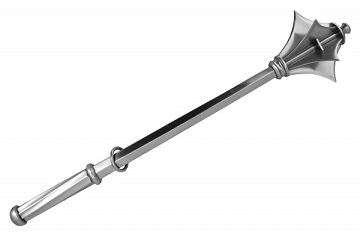 However at around the same time the mace developed a separate identity as a symbol of civic office. In this guise the mace is still in use, for example as the physical symbol of the monarch's authority over the British Parliament or as excercised by the Lord Mayor of London. And isn't a mace also the name given to the ceremonial 'conductor's staff' carried by drum majors, whether in military bands or civillian marching bands? 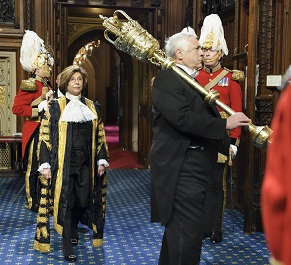 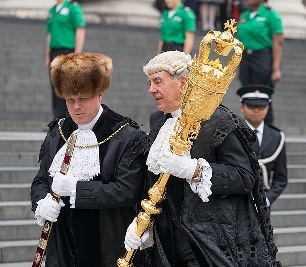 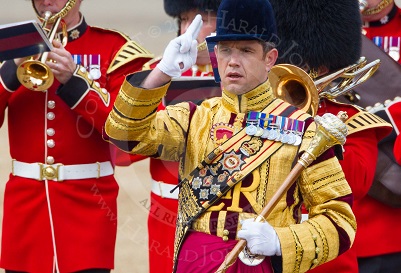 I suspect maces as ceremonial symbols of authority grew out of the idea that a blunt mace, somewhat like a policeman's truncheon, was a supposedly non-lethal implement suitable for crowd control by civic guards. Furthermore I have a vague recollection that it was widely understood in medieval Europe that those with religious clerical status were forbidden from using a sword, which supposedly is why Bishop Odo (William the Conqueror's half brother) was depicted on the Bayeux tapestry as fighting at the battle of Hastings using club or blunt mace.  Or is Odo actually carrying a flail? The flail was a hinged club based on the agricultural implement typically used for threshing grain which had been another ancient pharonic symbol of domestic authority but is also likely the ancestor of that particularly nasty medieval weapon the spiked chain mace?  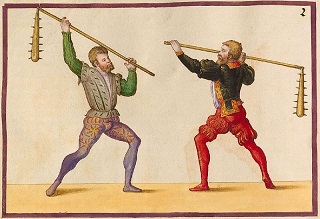 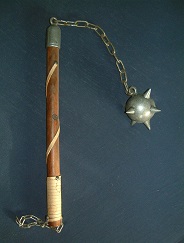 Flails and hinged maces: from threshing grain to thrashing foes. Nowadays the term mace is also used for a hand-held, tear-gas type spray, presumably because like a medieval club, it can be used to incapacitate an opponent in a relatively non-lethal way and without imparting obvious damage to the body. Another term with an origin in a battlefield weapon is the expression to be dragooned (ie coerced or compelled by threats or harassment) into doing something. This derives from dragoon, a type of mounted soldier and their use in 17th century France to intimidate Huguenot families into converting to Catholicism by the billetting of such troops on them, a policy referred to at the time as 'les Dragonnades'.  A Protestant drawing of one of Louis XIV's dragoons threatening a Hugenot (1686). The original dragoons took their name from their principal weapon, the 'dragon' (or draggon or dragone) which was type of heavy pistol or short-barrelled carbine-type wheel-lock firearm, with a large calibre like a small blunderbuss, and so named after its flame-belching appearence when fired. Dragoons either fired from the saddle in volleys or might dismount to fire on foot and so act like highly mobile musketeers. However by the time of the Napoleonic wars, in Britain at least, the term dragoon had come to be used for a wide variety of different cavalry units. For example the senior British cavalry regiments of the Life Guards and the Blues and Royals were both called dragoons despite their primary weapon being a heavy sabre; any pistol they might carry was entirely secondary. |
|   | | Sponsored content
 |  Subject: Re: The Influences Of Historical Battlefields. Subject: Re: The Influences Of Historical Battlefields.  | |
| |
|   | | | | The Influences Of Historical Battlefields. |    |
|
Similar topics |  |
|
| | Permissions in this forum: | You cannot reply to topics in this forum
| |
| |
| |
